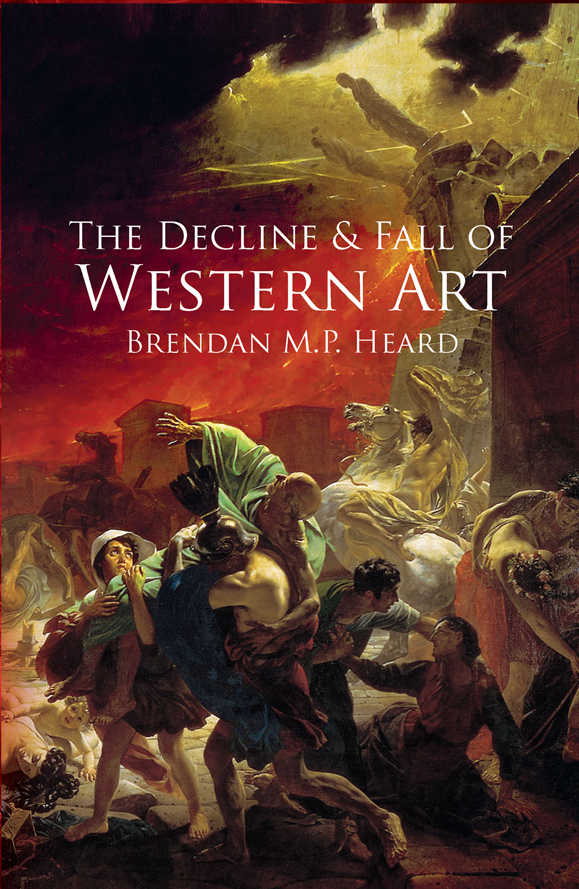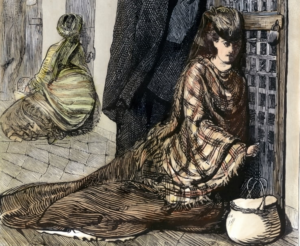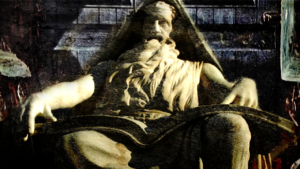The Golden Ratio: a formula for beauty

The formula for beauty that has been handed down to us is the Golden Ratio, also called the Golden Mean or Golden Section (in Latin, Sectio Aurea). It is the æsthetically perfect proportion and a root principle in all traditional European architecture, painting, sculpture and music. Two quantities are in the Golden Ratio if their ratio is the same as that of their sum to the larger of the two quantities. In an equation form, it looks like this: a/b = (a+b)/a = 1.6180339887498948420…
The Golden Ratio appears in patterns everywhere in nature, in the spiral arrangements of leaves, pine cones, shells and even in the human body. It is the ratio to which each part relates to the sum of those parts.
It was the Pythagoreans who arrived at our earliest recorded concept of the fundamental nature of numbers. The Hellenic philosophers saw number as the basis for all, both physical and metaphysical.
“Geometry has two great treasures: one is the theorem of Pythagoras, the other the division of a line into mean and extreme ratios, that is, the Golden Mean. The first way may be compared to a measure of gold, the second to a precious jewel.” — Johannes Kepler, astronomer (1571-1630)
Pythagorean philosophers such as Philolaus (470-385 BC) and Archytas (428-347 BC) explained the structure of the world in accord with numbers, the expression of which was found in studies of proportion. They discovered that the harmony and proportion in numbers was directly related to beauty in the world, or the result of it, and thus formulae could both explain and engineer beauty. This was true across all considerations of beauty, not just the visual arts. For example, Pythagoras considered music and astronomy to be related sciences. Geometry was number in space, music was number in time, and astronomy was number in space and time. With a root understanding of numbers and a morality of beauty-expressions, art and science appear clearly as one mutually striving cultural expression. The word technology does not to our modern ears have a connotation of art or craft, though it derives from the Greek techne (τέχνη), meaning art, skill, cunning of hand or relating to craft. The Golden Ratio demonstrates the link between the tangible world and the imagined, the physical and the metaphysical. It is the rational summation of art as a system reducible to a number and proportion. Proportion is thus a key concept accounting for beauty. Symmetria, meaning good proportion, was the word commonly used for this vital classical concept. It is a straightforward and functional account for the sensed goodness attributed to visual beauty. The idea that philosophers and artisans once considered this a fundamentally objective rationale exposes the level of deceit we are burdened with under Modernist relativism. Symmetria was a fundamental design precept and remains so in all true art (including music). I am falling short in not including science and religion here as I should but we must continue from our modern perspective, where these disciplines are falsely bifurcated. The same beauty of proportion desired in art is found everywhere in nature, which is both hyper-rational and hyper-spiritual.
“Symmetry is a proper agreement between the members of the work itself, and relation between the different parts and the whole general scheme, in accordance with a certain part selected as standard.”
— Vitruvius
Plato himself, of whom it is said all other philosophy is but a footnote, has many passages relating to good proportion or the ratio of parts. Alongside symmetria, Plato had a theory revolving around eternal, idealized Forms that act upon the world. Things become beautiful because they decide to take part in the Form of beauty. Plato also said this Form of beauty was also directly associated with the Form of good. In his Symposium, the Form of beauty was also associated with the acquisition of knowledge, which inspired inquiry in the world and led to the sciences. To think of beauty (and goodness) as corporeal, idealised Forms that the real world can only move towards in exultation and learning, means they are absolute and everlasting. The tangible result of this insight is the unsurpassed beauty and confidence of traditional Western art.
The great Neoplatonist Plotinus (204-270 AD) expounded on the notion that Intellect (nous) is the cause of beauty, that it is the Intellect that imposes the Forms on to passive matter, thus producing beauty. Those entities that do not participate in the Forms of beauty and intellect are ugly. Plotinus said the Form is therefore capable of producing beauty by virtue of its being an instrument of the Intellect that creates order and structure out of chaotic matter in the universe. In the macrocosmic sense this is the same work Greek sculptors Phidias (480-430 BC) and Polykleitos (died 420 BC) performed when creating their timeless sculptures. Their intellect was the instrument that derived primal Forms from marble.
Polykleitus wrote in his treatise, entitled Kanon, how beauty derives from symmetria, and explained the construction the ideal human figure using ratios, rhythmic poses, and as a system of measure similar to that used in temple building. The Kanon (meaning measure or law), which is now sadly lost, discussed not only ideal proportions for the parts of the human body in relation to one another, but how sculpture of the human figure must achieve a dynamic counterbalance between relaxed and tensed body parts, and the directions in which the parts move. He put these principles into practice in his own sculpture, which then formed a framework for all ordered European sculpture since. The basis of this art is number, tempered with philosophy and spirituality, with an aim to express beauty values in the exultation of goodness, truth and reason.
This idealization with the human form as premise was a groundbreaking civilizational achievement. It is an advanced level of otherworldly perfection, which captures both the Form of the subject and the Form of beauty (and thereby goodness): ennobling and boundless. It is more or less, in fact, the exact opposite of what Modernist art values teach, which is that idealism does not exist at all and we should all wallow in valueless subjectivity (nihilism) and excuse ugliness. When you see a Greek sculpture, you sense immediately the greatness of the underlying civilization or philosophy. Who made this? What is the mystery of this achievement? You know you have been witness to the artistically superhuman and that work can never be unseen. You know too, in an instant, the near impossibility of surpassing the maturity of that idealism. That it presents a monumental task, requiring confidence and optimism, because it has expended such effort that it has tapped into the eternal. And setting this near impossibly high standard as the goalpost of excellence has been antiquity’s greatest gift to the legacy of European art. That is the track whereon was set the locomotive of Promethean achievement. This is the vitality of tradition, and why it cannot be discarded out of hand for convenience-technology and a confused and vacant newness. It is the striving upward, reaching for the impossible, and it has memory.
In the concept of heroic nudity, a Hellenistic idealism also championed in the Kanon, we find another recurring artistic theme from all subsequent (pre-Modernist) Western art. Nudes were not celebrated in the lusty, juvenile way they might be today, nor depicted in warts-and-all realism. Avoiding that obvious realism was the stratagem to ennobling the naked form. Hellenic men were depicted as fit, ready for war, but formularized to avoid any tawdry sexual aspect that takes away from that visual nobility. This creates the perception that the figures are closer to demi-gods or titans than common men — by insinuating a powerful aloofness from worldly pleasures and animalistic distractions. This is why their genitals were not enlarged, and their gesture or expression betrayed nothing resembling sensuality or material lust, despite being both nude and athletically exaggerated. To suggest divine nobility, they presented the stark honesty of nudity, the majesty of fitness, but without the invocation of sexual desire. This is no easy feat.
The same can be said, and more importantly so, for female sculptural nudes, who are even more difficult to portray without sexual connotation. Yet Hellenic female nudes, while beautiful, are neither voluptuously sexual nor realist-ugly. Rather, they are ennobled with the finer virtues, with the form of femininity. They are portrayed in sybaritic nakedness, yet they do not exude sexual lewdness. Again, not an easy achievement, considering the powerful allure of the fairer sex. But this is the achievement of Greek sculptors. Long torsos, Roman noses, smaller cone-shaped breasts, delicately posed hands and feet, juxtaposed matronly hips and stances, and all balanced with Euclidian proportions. The accentuated points of beauty are not the obvious but rather the sense of weight in the figure and the naturalistic folds suggesting action of the flesh. An artistic view of beauty so mature it transcends (without rejecting) erotic desire.
Focus on what would seem mundane elements elevates the subject to the divinity of high art. The position of a finger, perfectly fleshed, the weight of the gait. These idealized marble females appear fertile, matronly and goddess-like. They inhabit metakosmia: empty spaces between worlds in the vastness of infinite space. Because each tiny section of Hellenic sculpture is created in relation the rest and the whole, in accordance with the Golden Ratio, that sense of potency (the eternal) lives within them, even when the works are damaged or survive in fragments. As the French sculptor Rodin said: “Beauty is like god, a fragment of beauty is beauty complete.” The sculptures are inspired by nature and are therefore devotional to nature, and like her they are timeless. This relates again to the magic of equilibrium and rhythmos found in the Golden Ratio. These principle of ratios and sacred geometry will always apply, to all craft, from Mozart sonatas to basket weaving. Aspiring artists must understand this formulation and the philosophy surrounding it as fundamental to art, yet today they are not even taught about its existence. The formula’s importance to the Hellenes meant their art was not a passing onerous hobby, taken glibly as we sadly see today. It was religious, it was tied into daily reality and the eternal, and superseded all other considerations, or was intrinsic to them. Art was of paramount importance. That cogency was common knowledge to all successful civilizations and this simple reality is somehow hidden from us now. True art has no end but its own perfection.
“For he who would proceed aright… should begin in youth to visit beautiful forms… out of that he should create fair thoughts; and soon he will of himself perceive that the beauty of one form is akin to the beauty of another, and that beauty in every form is one and the same.”
— Plato
When the Roman architect Vitruvius (died 15 AD) used this concept of symmetria in his seminal work De Architectura, he explained it in terms of specific numerical ratios. Vitruvius noticed that ancient architects always used a system of proportions to ensure harmonious design, rather that picking each dimension with no regards to the others in a structure. For most of history and all worthwhile architectural epochs, this was achieved using nothing more than straight edge, compass and stretched cord.
The power of the hand-made.
Thus, as per Leonardo’s Vitruvian Man (after Vitruvius, around 1490), beautiful proportions are found in the same ratios whether it is in the distance from the chin to the scalp on a human head or the relation of the placement of windows on a building’s facade. All good proportion follows the beauty Form — and the subject is interchangeable.
The Roman commitment to Hellenistic beauty values can still be seen today in their surviving monumental aqueducts and public buildings. These æsthetic leftovers of empire have inspired our forebears again and again, as they do us today. They are a reminder: do not succumb to luxury or mediocrity, or aim anywhere but upwards — for instinctual and intellectual idealism. The Romans understood well and prudently that ultimately in life, there is only weakness or strength. We are very far from the days of the Colosseum, stunted and childishly reliant on technology, while a man you never see kills the chickens and cows you eat every day. A Roman noble was expected to hunt boar with his spear held in front of him, unmoving, to be gored or run the beast through. To turn away, a coward, was the only way to lose. Honesty and truth above safety and comfort. Modern Westerners live in comfort and think sadly little of the honour or courage espoused by Homer, brainwashed into dismantling what was built for us by our betters. We have a tough, ancient lesson to re-learn, a lesson that is going to be more taxing the longer we put it put off.
“Ex nihilo nihil fit (Nothing comes from nothing)”
– Lucretius
A chapter from my book













“Again, not an easy achievement, considering the powerful allure of the fairer sex.”
I must disagree so much on this statement. Females were considered less beautiful than males in ancient Greece.